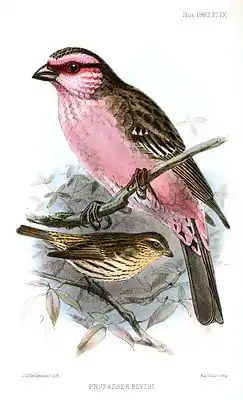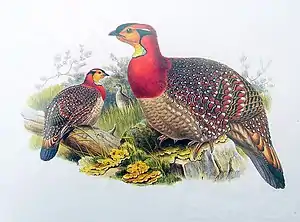Edward Blyth
Edward Blyth (* 23. Dezember 1810 in London; † 27. Dezember 1873 ebenda) war ein englischer Zoologe und Ornithologe. Er ist bekannt als einer der Begründer der indischen Zoologie.

Leben und Wirken
Blyth wurde am 23. Dezember 1810 in London geboren. 1841 reiste er nach Indien, um der Kurator der Royal Asiatic Society of Bengal zu werden. Er begann mit der Aktualisierung der Kataloge des Museums und veröffentlichte 1849 einen Katalog über die Vögel der Asiatic Society (Catalogue of the Birds of the Asiatic Society). Selbst konnte er nicht viel Feldarbeit leisten, aber er beschrieb viele Vogel-Arten, die er von Hume, Tickell, Swinhoe und anderen bekam. Bis 1862 blieb er Kurator, zu dem Zeitpunkt zwang ihn seine schlechte Gesundheit zur Rückkehr nach England. 1881 wurde sein Werk The Natural History of the Cranes veröffentlicht.
Dedikationsnamen
Charles Lucien Jules Laurent Bonaparte ehrte ihn 1854 im Gattungsnamen Blythipicus, ein Name, der sich aus seinem Namen und dem lateinischen Picus für Specht zusammensetzt.[1] Mit einer Unterart der Schlichtprinie (Prinia inornata blythi (Bonaparte, 1850)) hatte er ihn bereits 1850 gewürdigt.[2] Der Somalistar (Onychognathus blythii) wurde ihm 1859 von Ernst Hartert gewidmet.[3] Alfred Russel Wallace widmete ihm 1864 Psittaculirostris desmarestii blythii, eine Unterart des Buntbrust-Zwergpapageis, da dieser ihn auf die Unterschiede zu bereits beschriebenen Arten hinwies.[4] Major John Biddulph nannte 1882 eine Unterart des Weißbrauengimpels, die heute unter dem Namen Carpodacus thura blythi geführt ist, zu seinen Ehren.[5] Die Unterart Cyornis rufigastra blythi[6] des Mangroveblauschnäppers wurde von Christian Gottfried Giebel im Jahr 1875 als Synonym für Cyornis simplex Blyth, 1870[7] eingeführt. Auch im Namen einer Unterart des Graukopfstars (Sturnia malabarica blythii (Jerdon, 1845)) findet sich sein Name.[8] 1870 würdigte ihn Thomas Caverhill Jerdon erneut im Namen des Blythtragopan (Tragopan blythii (Jerdon, 1870)).[9] Jules Verreaux würdigte ihn 1871 in der Unterart Trochalopteron affine blythii des Schwarzscheitelhäherlings.[10]
Außerdem kam Blyth in den Synonymen Phoenicopterus blythi Bonaparte, 1857[11] (entspricht dem Zwergflamingo (Phoeniconaias minor)), Alcippe poioicephala blythi Collin & Hartert, 1927[12] (entspricht der Graukopfalcippe (Alcippe poioicephala karenni)), Muscicapa blythi Rothschild, 1921[13] (entspricht dem Elsterschnäpper (Ficedula westermanni collini)), Phaiopicos blythii Malherbe, 1849[14] (entspricht dem Rötelspecht (Micropternus brachyurus)), Gorsachius melanolophus blythi Hachisuka, 1926[15] (entspricht der Nominatform des Wellenreihers (Gorsachius melanolophus)) und Sylvia curruca blythi Ticehurst & Whistler, 1933[16] (entspricht der Nominatform der Klappergrasmücke (Sylvia curruca)) zu Ehren.
Weiters beschrieben 1870 Francis Day die zu den Gebirgswelsen gehörende Art Myersglanis blythii,[17] 1876 William Theobald mit Mocoa blythii[18] ein Synonym zu der zu den Skinken gehörenden Unterart Scincella ladacensis himalayana, 1867 Franz Steindachner mit Euprepes blythi[19] ein Synonym zu der zu den Skinken gehörenden Art Asymblepharus himalayanus, 1859 Robert Fisher Tomes das Kleine Mausohr (Myotis blythii),[20] 1853 die zu den Schildschwänzen gehörende Art Rhinophis blythii[21] und 1920 George Albert Boulenger die zu den Froschlurchen gehörende Art Limnonectes blythii.[22]
 Carpodacus thura blythi illustriert von John Gerrard Keulemans
Carpodacus thura blythi illustriert von John Gerrard Keulemans Sturnia malabarica blythii gelegentlich auch als eigene Art Sturnia blythii geführt
Sturnia malabarica blythii gelegentlich auch als eigene Art Sturnia blythii geführt Blythtragopan illustriert von Joseph Wolf
Blythtragopan illustriert von Joseph Wolf Trochalopteron affine blythii illustriert von John Gould
Trochalopteron affine blythii illustriert von John Gould
Werke
- The Magazine of Natural History 1835 bis 1837
- Notes relating chiefly to the Birds of India. In: The Ibis (= new series). Band 6, Nr. 22, 1870, S. 157–176 (biodiversitylibrary.org).
Literatur
- John F. Riddick: The History of British India: A Chronology. Praeger, Westport, Connecticut, London 2010, ISBN 978-0-313-32280-8 (books.google.de).
- Charles Lucien Jules Laurent Bonaparte: Conspectus generum avium. Band 1. E.J. Brill, Leiden 1850 (biodiversitylibrary.org).
- Charles Lucien Jules Laurent Bonaparte: Conspectus Volucrum Zygodactylorum. In: Ateneo Italiano. Band 2, 1854, S. 116–129 (books.google.de).
- Charles Lucien Jules Laurent Bonaparte: Conspectus generum avium. Band 2. E.J. Brill, Leiden 1857 (gallica.bnf.fr).
- John Biddulph: On birds of Gilgit. In: The Ibis (= 4). Band 6, Nr. 20, 1882, S. 266–290 (biodiversitylibrary.org).
- Ernst Hartert: Monographische Uebersicht der Glanzstaare (Lamprotornithinae) Africa's. In: Journal für Ornithologie. Band 7, Nr. 1, 1859, S. 1–36 (biodiversitylibrary.org).
- Albert Collin, Ernst Hartert: Nomina Mutanda. In: Novitates Zoologicae. Band 34, 1927, S. 50–52 (biodiversitylibrary.org).
- Christian Gottfried Giebel: Thesaurus ornithologiae : Repertorium der gesammten ornithologischen Literatur und Nomenclator sämmtlicher Gattungen und Arten der Vögel, nebst Synonymen und geographischer Verbreitung. Band 2. Brockhaus, Leipzig 1875 (biodiversitylibrary.org).
- Alfred Russel Wallace: On the Parrots of the Malayan Region, with Remarks on Their Habits, Distribution, and Affinities, and the Descriptions of Two New Species. In: Proceedings of the Scientific Meetings of the Zoological Society of London for the Year 1864. 1864, S. 272–295 (biodiversitylibrary.org).
- Thomas Caverhill Jerdon: Illustrations of Indian ornithology: containing fifty figures of new, unfigured and interesting species of birds, chiefly from the south of India. P.R. Hunt, American Mission Press, Madras 1847 (biodiversitylibrary.org).
- Thomas Caverhill Jerdon: Notes on new species of Birds from North-Eastern Frontier of India. In: Proceedings of the Asiatic Society of Bengal. 1870, S. 59–61 (biodiversitylibrary.org).
- Jules Verreaux: Description des oiseaux nouveaux ou incomplètement connus collectés par M. l’Abbe Armand David pendant son voayage dans le Thibet Oriental et la partie adjacente de la Chine. In: Nouvelles archives du Muséum d’histoire naturelle. Band 7, 1871, S. 25–66 (biodiversitylibrary.org).
- Lionel Walter Rothschild, 2. Baron Rothschild: On a collection of birds from West-Central and North-Western Yunnan. In: Novitates Zoologicae. Band 34, 1921, S. 14–67 (biodiversitylibrary.org).
- Alfred Malherbe: Description de quelques nouvelles espèces de Picinées (Picus, Linn.). In: Revue et magasin de zoologie pure et appliquée (= 2). Band 1, 1849, S. 529–544 (biodiversitylibrary.org).
- Masa Uji Hachisuka: A Revision of the Genus Gorsachius. In: The Ibis. Band 68, Nr. 3, 1926, S. 585–592, doi:10.1111/j.1474-919X.1926.tb05627.x.
- Claud Buchanan Ticehurst, Hugh Whistler: What is Curruca affinis Blyth? In: The Ibis. Band 75, Nr. 3, 1933, S. 554–556, doi:10.1111/j.1474-919X.1933.tb03350.x.
- Francis Day: Remarks on some of the Fishes in the Calcutta Museum. In: Proceedings of the Scientific Meetings of the Zoological Society of London for the Year 1864. 1870, S. 511–531 (biodiversitylibrary.org).
- Franz Steindachner: Reise der österreichischen Fregatte Novara um die Erde: in den Jahren 1857, 1858, 1859 unter den Befehlen des Commodore B. von Wüllerstorf-Urbair (= Zoologischer Theil: Reptilien). K.K. Hof- u. Staatsdr. ; in Comm. bei Gerold, Wien 1867 (digital.slub-dresden.de).
- William Theobald: Descriptive catalogue of the reptiles of British India. Thacker, Spink, Calcutta 1876 (biodiversitylibrary.org).
- Robert Fisher Tomes: Description of four undescribed species of bats. In: Proceedings of the Zoological Society of London. Band 25, 1857, S. 50–54 (biodiversitylibrary.org).
- Edward Frederic Kelaart: Description of new or little-known species of reptiles collected in Ceylon. In: The Annals and magazine of natural history; zoology, botany, and geology being a continuation of the Annals combined with Loudon and Charlesworth's Magazine of Natural History (= 2). Band 13, 1853, S. 25–30 (biodiversitylibrary.org).
- George Albert Boulenger: A Monograph of the South Asian, Papuan, Melanesian and Australien Frogs of the Genus Rana. In: Records of the Indian Museum. Band 20, 1920, S. 1–226 (biodiversitylibrary.org).
Einzelnachweise
- Charles Lucien Jules Laurent Bonaparte (1854), S. 124.
- Charles Lucien Jules Laurent Bonaparte (1850), S. 281.
- Ernst Hartert, S. 32.
- Alfred Russel Wallace, S. 285.
- John Biddulph, S. 283–284, Tafel IX.
- Christian Gottfried Giebel, S. 631.
- Edward Blyth (1870), S. 165.
- Thomas Caverhill Jerdon (1845 (1847)), Tafel 22 & Text.
- Thomas Caverhill Jerdon (1870), S. 60.
- Jules Verreaux, S. 37.
- Charles Lucien Jules Laurent Bonaparte (1857), S. 146.
- Albert Collin u. a., S. 50.
- Lionel Walter Rothschild, S. 48.
- Alfred Malherbe, S. 534.
- Masa Uji Hachisuka, S. 591.
- Claud Buchanan Ticehurst u. a., S. 556.
- Francis Day, S. 525.
- William Theobald, S. 59.
- Franz Steindachner, S. 46.
- Robert Fisher Tomes, S. 53.
- Edward Frederic Kelaart, S. 26.
- George Albert Boulenger, S. 43.